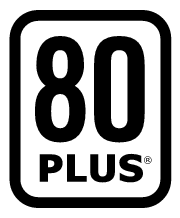80 PLUS
80 PLUS is a North American initiative to promote PC power supplies, which have an efficiency of 80 % or higher. The initiative also lists compliant devices and provides the appropriate measurement protocols available on the internet.
Requirements
The initiative calls for a " 80 -PLUS " certification that power supplies for desktop computers and servers at the load points 20%, 50 % and 100 % respectively achieve an efficiency of at least 80 %. In addition, the power factor at 50 % load shall be at least 0.9. For the higher certifications " 80 PLUS Bronze ", " 80 PLUS Silver ", " 80 PLUS Gold" and " 80 PLUS Platinum " the demands on the efficiency of each gradually increased, with a focus on the most frequently used load range of 50%. " 80 PLUS Platinum " also places higher demands on the active PFC, as a power factor of at least 0.95 is required.
History
- Ecos & EPRI developed the Generalized Internal Power Supply Efficiency Test Protocol ( general test protocol for internal power supplies ) for PC power supplies with multiple outputs.
- In March 2004, the " 80 -PLUS " idea was presented as an initiative on the ACEEE Market Transformation Symposium.
- In February 2005, the first market-ready " 80 -PLUS " was introduced certified PSU Sea Sonic.
- 2006 Advanced Energy Star requirements for their future Energy Star 4.0 computer specifications to the " 80 -PLUS " requirements.
- In November and February 2006, HP and Dell certify their power supplies based on the " 80 -PLUS " specifications.
- On 20 July 2007 the Energy Star Computer Specification 4.0 came into force. The specification includes the " 80 -PLUS " requirements for desktop computers.
In December 2007, " 80 -PLUS " were already more than 200 power supplies on the market certified and thus the future standard.
In the first quarter of 2008, the standards were revised to certify with Bronze, Silver and Gold higher efficiency level. While with "bronze" certified models followed soon, models of the two higher certifications appear until the mid to late 2009. Stage " silver " is partially skipped by manufacturers or used for cheaper models. End of 2009, followed by the step " 80 PLUS Platinum ", previously partially discussed as " 90 PLUS" which requires an efficiency of consistently above 90% and even 94 % at medium load. Selbige is initially valid only for server power supplies; 2010 was followed by a slightly modified version for desktop systems.
As of Easter 2010, about 350 models were available with a certification in Europe, of which about half " Bronze " or greater were certified. The number of certified power supplies, many of which, however, are merely conceptual studies, meanwhile, stood at about 2000.
Mid-2011 (June 10, 2011) has arrived at more than 550 the number of certified and available in Europe power supplies. The two lowest levels (Standard and Bronze) make it out of each 200 models; Silver and gold to share the other 150 Only 40 models with a platinum certification at this time in the trade. The number of certified models in total (including concept studies) is a similar distribution at just 3,000.
Criticism
The measurement of the power supply takes place in a laboratory environment at 23 ° C air temperature. Due to the heat of the computer or a warmer ambient temperature in summer power supplies are, however, operated by many users at higher temperatures. However, higher temperatures have a negative effect on the efficiency of the power supply, since the efficiency of the built- in semiconductor decreases at higher temperatures.
There is also the possibility that measured in the 80 -PLUS- measurement laboratory efficiency will be higher than that of free commercially available specimens, such as when the power supply manufacturer for cost reasons, individual components in later batches interchanges or so-called " Golden Samples", ie specifically for against inefficient measurement laboratory prepared, not commercially available copies, one for the measurement ends.










